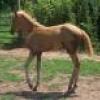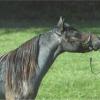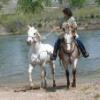Why has my mare got black AND white spots?
Forums
Re: Why has my mare got black AND white spots?
Her sire is a silver black tobiano and her dam is a grulla with a blanket spot (she showed no sign of spotting till she was 5yrs old!) so no grey...plus I think, going by that single white streak in her mane, she is a black pintaloosa? She looked plain black till this year.
Re: Why has my mare got black AND white spots?
If the streak in her mane were caused by Tobiano it would always have been there, form a foal.
I think it is just part of the Appy.
You have two possibilities with the white spots, they could be Birdcatcher, but in that case I also would have expected them to have been there since birth, or they could just be varnish, which is the most likely explanation.
Re: Why has my mare got black AND white spots?
She had a cluster of a few white hairs in her mane from birth, but when she was small and her mane shorter we didnt take much notice of it as it was barely noticeable...now it looks like the "Mallen Streak" like the Catherine Cookson book!! lol So will her "varnish" keep spreading and getting lighter and the black spots show up more as she gets older?
Re: Why has my mare got black AND white spots?
Don't roan horses sometimes look like that? I think the dark spots are called 'corn spots'?
I'm still learning about patterns, but I find myself thinking MP and RF's explanations are very plausible, though CK's ideas also have me thinking, too....
I should warn you, sometimes, 'thinking' is a baaaaad thing, for me! ([i]and for those around me[/i]!) :lol:
Re: Why has my mare got black AND white spots?
Im starting to find spots a bit exciting!! :bounce :laugh1 I never liked them or had any interest in them before. I was at a show on saturday and saw a mare I sold 3yrs ago when she was 5, I had her from a baby when all she had was a blanket (she was black then) then by her first shedding her black turned to a liver colour and her spots spread, finishing (I thought) as a near leopard at 5. Well at the show I didnt recognise her!!! She is now a full leopard..........all white and covered in dark chocolate spots!!!! So that has me wondering, will my 2yr old that I asked about here just keep getting more and more white accphotography? She does look roany over her body but then those white spots on her bum and back are solid.......and what about the white streak in her mane, is that from the spotting or did she get tobi from her sire? He has thrown a lot of minimal tobiano such as one small splash on the shoulder or hip or even one just on the back?
Re: Why has my mare got black AND white spots?
And that's why I say "true leopards" are the ones who are nose-to-toes from birth :laugh1 A mare like the one you sold, Slaney, 'looks' leopard, but doesn't have the gene(s) to make a nose-to-toes leopard without having a sire that has the nose-to-toes gene(s).
Diane
Re: Why has my mare got black AND white spots?
What a cutie! Yeah, that's just LP doing it's thing. Dark spots and white spots are not uncommon.
In my experience, a near-leopard (like the mare Slaney sold) can indeed produce a nose-to-toes leopard -- I've had this happen in my own breeding program many times. The leopard gene (Patn1) doesn't always express as a nose-to-toes; it can range anywhere from 60% to 100% white, with the average being around 80%.
A true spotted blanket will be born with a dark head, even if the blanket is quite large. It may roan eventually and leave varnish marks behind, maybe even a few spots, but it will not be heavily spotted on the face. If the "spotted blanket" roans out to reveal dense spotting all over the body, it is indeed a "true leopard".
Re: Why has my mare got black AND white spots?
I agree with Diane, a True Leopard is born Leopard, a Near Leopard is always a Near Leopard whatever it comes to look like.
And I actually think it has to do with the Blanket pattern, so the Near Leopard is an extended Blanket that has not extended over the whole body.
Like varnish, it appears to be able to continue extending throughout life.
Sometimes it appears to be inhibited and the pints stay dark.
I find Appy in Minis very "murky" as they often start off like this mare and then progress slowly through life, often never clearing up at all, and varnish is almost always present.
I think this mare is definitely varnish, she may or may not "spot out" it depends on how inhibited the pattern is.
Re: Why has my mare got black AND white spots?
Diane, if your stud was born a snowcap, then he was still a snowcap no matter how white he became. Snowcaps, being homozygous for LP, will usually varnish out completely; sometimes it's hard to distinguish them from few-spots. A few-spot will quite often have dark areas on the legs, triangles at the coronet band, dark areas in the flanks and armpits, dark rimmed ears, and maybe a few spots on the shoulders, neck, or face. Snowcaps [i]usually[/i] don't. I was just lucky that my snowcap held his color very well; his blanket was still very distinct as a 9-year-old, with very little roaning. Being black helped.
I disagree that a near-leopard is an extended blanket. In my opinion, it's just a lower expression of the leopard gene. What I've observed in my own herd (this may not hold true in other breeding programs) is that the fillies tend to be near-leopards and the colts tend to be nose-to-toes. These fillies may or may not roan out to resemble true leopards. However, they will go on to produce just as if they were true leopards (usually producing near-leopard fillies and nose-to-toes colts). I've had this happen many many times in my 30+ years of breeding Appaloosas (mostly leopards).
Minis do have an amazing ability to inhibit LP color patterns, but I agree that the mare pictured is just a varnish roan (and a very pretty one!). The mare she sold is the one I was referring to a leopard or near-leopard.
There's nothing official about the terms "leopard" and "near-leopard". The ApHC doesn't use them at all. Some people only call a horse a leopard when it's a nose-to-toes. A near-leopard is often called a spotted blanket. That's fine. However, since the near-leopard does, in my experience, have the leopard gene (Patn1) and can produce leopards, I prefer to call them near-leopards (to reflect their genotype) rather than spotted blankets. If they spot out completely, I just call them leopards. But that's just semantics.
Re: Why has my mare got black AND white spots?
You do have to accept that the ApHC is not the be all and end all of the Spotted horse and pony...there are actually loads of other countries with LOADS of other horses and ponies involved.
The BSpPS uses Leopard and Near Leopard, therefore, in my country, that is the term we use.
Sorry to be so stuffy about it, but I have noticed this slight tendency of Americans in particular to forget there is actually a world outside their own country!! :rofl
Re: Why has my mare got black AND white spots?
I'm sure the AMHA can trump anything you could come up with regarding colur/pattern....how about a black form two chestnuts or a genetically proven phenotypically white but genetically black horse registered as.....drumroll....Cremello!!!!
They did argue that one.
Re: Why has my mare got black AND white spots?
[quote="NZ Appaloosas"]I hope you challenged that?
Diane[/quote]
I did. I sent in close-ups of his spots and characteristics, including the heavily mottled skin on his neck where he was shaved for an IV.
I just assumed they'd recognize a fewspot when they saw one....







Re: Why has my mare got black AND white spots?
What was her base color? I am assuming she's a mini - which throws nearly all the rules out the door :laugh1 - but does she by chance have an "appy-marked" parent? :?:
If she's a grey I'd suspect that it could just be a phase of grey - flea bites with maybe some Bend Or spots. If she has a spotted parent, then she could have a combination of grey and PATN/Lp... :bounce
I think she has a nice color even if it is a bit unique :love